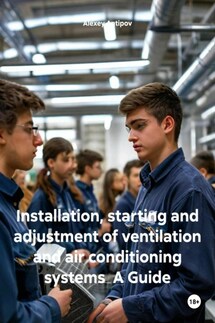Installation, starting and adjustment of ventilation and air conditioning systems A Guide - страница 18
• Round section with electric drive;
• Rectangular cross-section with electric drive;
• Circular cross section with manual drive;
• Rectangular cross-section with manual drive;
Air dampers are designed to regulate the amount of air and are used in air ventilation systems, air heating and other sanitary systems with an operating pressure of up to 1000 Pa.
Questions to Chapter 5
1. For what purpose are air distribution devices used?
2. Name the main characteristics of air distribution devices.
3. What factors are taken into account when choosing the type of air distribution device in the room?
4. What is the value of the dynamic pressure required for the operation of the lobe check valve?
5. What is the purpose of electric heating of air dampers, in which cases it is used?
Chapter VI. Mounting tools, fixtures and accessories for mechanization of installation work
Installation of ventilation systems is carried out by a team. As a rule, the integrated team of ventilation fitters includes two or three people with related specialties of an electric welder and a gas cutter. The numerical composition of the team is usually six to seven people. Each team is provided with a set of tools, which allows the team or its units to independently perform almost the entire scope of work on the installation of ventilation systems.
Table 6.1.
Table 6.2
Recommended set of electric welding equipment and tools for a team of locksmiths – ventilators
Table 6.3
Tools for gas cutting of steel
Table. 6.4.
Basic data of non-self-propelled inventory means of scaffolding and rigging
The connection of the end of the box with the flange is carried out using a TRUMPF TF 350–2 manual press. The fastening element is a "press rivet", which is cut and molded from the material of the workpiece in one working stroke of the punch (punch). This mechanical process of joining metal sheets is known as "offset connection" – the upper sheet is connected to the lower by kinematic closure. Its main advantage over traditional spot welding is that there is no damage to the surface due to heating, the butt joint is corrosion resistant. The TF 350–2 press is designed both for joining uncoated sheets and galvanized, painted, polymer-coated sheets. Preliminary and final processing with such "cold welding" is not required, there are no costs for screws, rivets and other connecting elements. For ease of operation, the punch, which forms the "rivet" with a continuous pressing blow, is installed in a movable lever. Thus, the tool frame can be "opened" with a single movement of the hand in order to easily and quickly install the tool at the desired point of the tire. At the same time, the flange height is allowed up to 40mm. A special cone puller makes it possible to fasten the tire with the box as close as possible to the edge of the duct. Depending on the technical and aesthetic requirements, the connecting element can be concave into the surface of the box or protrude above the surface. It is possible to obtain an almost airtight connection for sheets of various thicknesses by choosing the appropriate matrix size. A set of tools is installed on the TRUMPF TF 350–2 press, in accordance with the specified total thickness of the sheets. Tool change is quick and easy and does not require special tools or skills. The productivity of the TRUMPF TF 350–2 press is 2 rivets per second. The tool is suitable for both portable and stationary applications.






